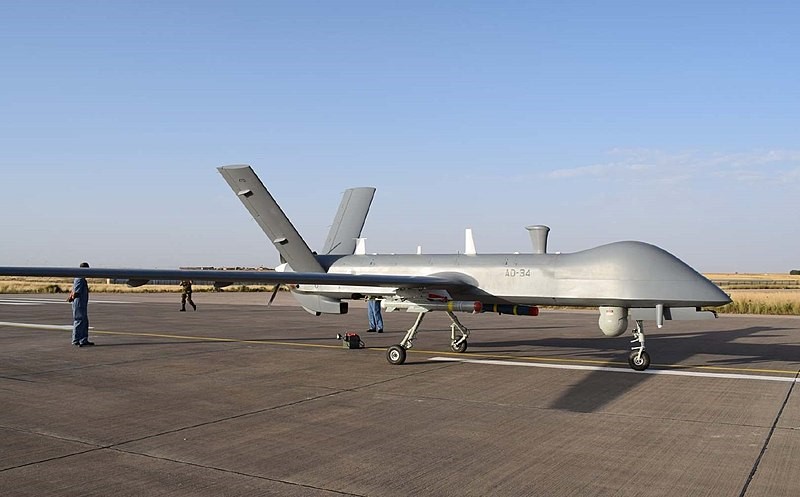Japanese F-15 Fighters Stop China’s Most Advanced WZ-7 Soaring Dragon Flying Over East China Sea

- The unmanned aircraft probably has AI-enabled networking and sensor fusion, highly encrypted data links that are hard to jam, ISR links with Chinese satellites, and the ability to share battlefield information with fighting forces.
- As Chinese threats and attacks on Taiwan and its overall growth in the Indo-Pacific continue to raise tensions in the area, the drone may become a regular visitor to the area.
The Japanese Defense Ministry said on January 1 that its Air Force had stopped China’s WZ-7 Soaring Dragon drone over the East China Sea. This was the first time anything like this had happened. Even though the intercept was thought to be a one-time thing, another WZ-7 flew over the same spot the next day.
On January 1, the Chinese military drone WZ-7, which is thought to be one of its most advanced, flew over the water between the islands of Okinawa and Miyakojima in southwestern Japan.
Even though the drone was not in Japanese airspace, the Japanese Air Self-Defense Force sent out fighter jets (most likely the F-15J) to catch it.
This is interesting because less than a month ago, the WZ-7 was seen near the disputed LAC border with India in the Tibetan area. At the time, Planet Labs released satellite photos that showed the drone at Shigatse Base, two days after troops from India and the People’s Liberation Army (PLA) fought in Tawang, Arunachal Pradesh.
But since it was the first time the drone flew close to Japanese territory, the Japanese Self-Defense Force may have been caught off guard.
The Ministry says that the Unmanned Aerial System (UAS) took off from the East China Sea and flew between the islands of Japan on its way to the Pacific Ocean. Then, as it went west, it went back over the same path.
The path that the drone is said to have taken is interesting. The WZ-7 went through the Miyako Strait, which is a narrow channel between Okinawa’s main island and the Miyako Islands.
Recently, this is the path that aircraft carriers and other ships from the PLA Navy have taken to get to the West Pacific. Tokyo often pays close attention to and follows this move.
The Japanese Ministry of Defense also saw a second WZ-7 drone a day after the first one. The drone flew in the same area and took the same route from the East China Sea to the Philippine Sea. It flew close to Okinawa and other Japanese islands that were far away.
In this case, it wasn’t clear how close the drone flew to Japanese land. But it probably did not fly into Tokyo’s airspace.
The PLAN’s Liaoning Aircraft Carrier went through the Miyako Strait on January 1. For the past two weeks, it has been taking part in military drills.
The flattop was accompanied from the Philippine Sea to the East China Sea by the People’s Liberation Army Navy (PLAN) Type 055 destroyers Anshan and Wuxi, the Type 052D destroyer Chengdu, the Type 054A frigate Zaozhuang, and the Type 901 fast combat support ship Hulunhu.
So, it’s likely that the drone activity had something to do with or was related to the carrier’s transit. For example, if the PLAN sent a drone over the area before, during, or after the carrier’s transit, it could gather important information by watching the radars and communication systems of enemy forces.
Okinawa Island is in a good spot and is home to some of Japan’s best military equipment. It is also home to the Kadena Air Base, which recently got the US F-22 Raptor fighter jets to replace the F-15 Eagles, which were getting old and breaking down.
The Chinese dragon flew over the East China Sea.
Notably, China’s recent actions come just days after Japan said it would put a surface-to-air missile defence unit on the island of Yonaguni, which is near Taiwan. Japan has also said that it is willing to get long-range weapons to protect itself from its enemies in the region.
In December, Japan changed its national defence strategy and said it wanted to be able to strike back against “enemy territory” (China and North Korea) and spend 2% of its GDP on the military by 2027. China was also called a “strategic challenge to Japan’s security that has never been seen before” in the text.
There have been a lot of problems in the area for a while now. China and Russia are responsible for the most interceptions of foreign planes by the JASDF. But the presence of a drone is important, and it might happen more often in the near future.
With its unique joined-wing design, the WZ-7 Soaring Dragon intelligence, surveillance, and reconnaissance (ISR) drone could be used more often by China in the region. It has some of the same capabilities as the RQ-4 Global Hawk that Japan got in March 2022.
The wings and horizontal stabilisers of the WZ-7 are shaped like a diamond. The wings are swept back, while the tails are swept forward. The Guizhou Aircraft Industry Corporation made the drone, which was first shown at the Zhuhai Air Show in 2021 and at the Air Show in 2022.
The unmanned aircraft probably has AI-enabled networking and sensor fusion, highly encrypted data links that are hard to jam, ISR links with Chinese satellites, and the ability to share battlefield information with fighting forces. It is thought to have a range of 7,000 kilometres and be able to keep going for 10 hours.
As Chinese threats and attacks on Taiwan and its overall growth in the Indo-Pacific continue to raise tensions in the area, the drone may become a regular visitor to the area.







Facebook Comments